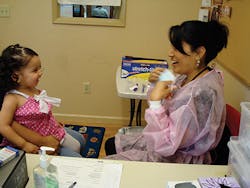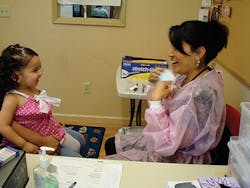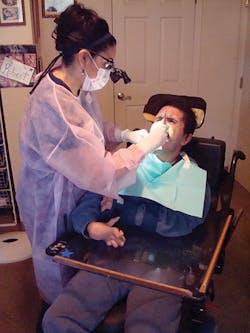RDHAPs in public health
BY CHRISTINE NATHE, RDH, MS
The dental hygienist spotlight this month focuses on a California registered dental hygienist in alternative practice (RDHAP) who serves those in need at her own practice and who is also a highly educated dental hygienist.
Katherine Kane, RDHAP, graduated from Riverside Community College in 1998 with an associate degree. In 1991 she completed her bachelor's degree in dental hygiene at Loma Linda University. In December 2004 she earned her RDHAP certification from the University of the Pacific. In 2005, she established On The Go, her dental hygiene practice, to provide underserved populations access to preventive dental hygiene services. She is also an active member of national, state, and local dental hygienists' associations.
Kathy spent six years as an infection control and Occupational Safety and Health Administration (OSHA) consultant, providing staff training and seminars to dental professionals. She also created a manual titled "Exposure Control Program for the Mobile Dental Hygienist."
--------------------------------------
Other articles by Nathe
--------------------------------------
Kathy is currently the dental provider for the Women, Infants, and Children (WIC) Dental Days Program of Sonoma County. As cofounder and clinical consultant for Community Dental Health Consultants, a branch of Sonoma County Community Action Partnership, she focuses on educating health-care professionals about oral health and provides training and program implementation services for oral health-care access programs.
She's had quite an amazing dental hygiene career, as you can see. I recently had the opportunity to learn even more about this entrepreneurial dental hygienist.
Were you involved in the creation of the RDHAP in California, and if so, do you have any comments about the development process?
I was not involved in the creation of the RDHAP, but I was in the first class of the University of the Pacific's program. I feel that many of us who were in that first class have continued to spearhead changes in the RDHAP profession through our membership and involvement in the ADHA component and state activities. A group of us started meeting shortly after we became RDHAPs to address issues that we were experiencing as members of the RDHAP profession. In addition to the original pilot project hygienists, I feel that many of us in those first classes continue to spearhead changes.
How did you get into public health and/or decide to become an RDHAP?
I have always felt the need to give back to my community, so volunteering has always been a part of my professional development. I volunteered with community clinics, health fairs, and Give Kids A Smile events. I gave oral health classes to different professional groups and to my children's elementary classes when they were young. Even after the kids were grown, the teachers continued to have me come in every year to present. When the RDHAP profession became a reality, I knew it was a path that I wanted to follow. The early connections I made and the people I met through volunteering led to the opportunities that I have today as an RDHAP.
What is your education level?
I have a bachelor's degree in dental hygiene from Loma Linda University and a certificate and state licensure for the RDHAP. I am currently entertaining the idea of enrolling in a master's degree program for public health.
What are your current positions?
I continue to work two days a month in private practice. I have been there for years, so many of my patients feel like family and friends. Plus, my dentist, Dr. Robert Leach, is a great boss and has supported my growth along the way, even as it has slowly taken me out of his practice.
I work in my own RDHAP business two days a week. I have a variety of patients, who range in age from one year old to 103, and I am the primary provider for the Dental Days WIC program in Sonoma County. I work in skilled nursing facilities and group homes for the developmentally disabled.
I also work part-time at Community Action Partnership (CAP) of Sonoma County in their Health Services Department, where I help develop and implement oral health programs for at-risk populations in the county. Our department runs such programs as the annual Give Kids A Smile event, the School Smile program, and a countywide Smile Survey through which I recently just finished screening over 1,700 children in our county.
We have also taken the WIC model and developed it into a medical-dental integration model for our county's federally qualified health centers (FQHCs). We placed an RDHAP directly into the medical clinics to provide dental care to the patients of the medical clinic. It has created collaboration between the medical and dental staff, and the patients benefit from increased access to preventive dental care.
With the guidance of Dr. Susan Cooper, the health services director at CAP, we developed a consulting branch of our department in response to requests from other agencies and persons around the state asking us how to implement our programs in their areas.
Part of our goal was to create a larger RDHAP workforce and opportunities for them, so I also began helping new RDHAPs with business start-up. Business start-up is often the most daunting part of becoming an RDHAP. We were taught hygiene - not business, so if I can help an RDHAP with all the start-up licensing, business and provider applications, marketing materials, and business focus, then they can get out there and start working sooner.
What type of advice would you give to a practicing hygienist who is thinking of doing something different?
Go for it! Take a risk. The opportunities are out there, and sometimes you have to make your own opportunities. Find like-minded people in your community. Find a mentor. Mentorship can lead to several successful collaborations and gathering a larger network of support for your programs. Work with other hygienists. When I first became an RDHAP, there were only a few in our county. I wanted for us to be able to work together, so I started hosting a quarterly networking meeting where we could share ideas, ask questions, and help other RDHAPs with their businesses and job opportunities. We continue to invite new RDHAPs in the county to participate, as well as any RDHs who are interested in the RDHAP profession. At our first meeting, we had six RDH attendees, two of whom went on to become RDHAPs. Our numbers continue to grow. Get involved in what's going on in your local, state, and national associations. We would not even have the RDHAP profession if not for our state association. They continue to fight for changes within our profession, and it is important to show support through your membership dollars and your voice. Attend meetings, and meet new people. Attending meetings provides me with opportunities to talk with other RDHAPs across the state, visit with friends, and expand my network.
Katherine Kane embodies the entrepreneurial spirit that seems to be common among the public health dental hygienists that I spotlight. Another common thread is the additional education level that most of these dental hygienists obtain. Networking with other dental hygienists and oral health stakeholders is paramount in increasing access to care for those in need. Katherine Kane is a perfect example of this!
I believe the RDHAP profession is the doorway to so many new paths for growth in preventive dental health. There is so much focus now on "place-based services," and the RDHAP has the ability to be directly involved in this. RDH
CHRISTINE NATHE, RDH, MS, is director at the University of New Mexico, Division of Dental Hygiene, in Albuquerque, N.M. She is also the author of "Dental Public Health Research" (www.pearsonhighered.com/educator), which is in its third edition with Pearson. She can be reached at [email protected] or (505) 272-8147.


